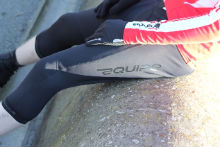
Presented at Freiburg University’s Radlabor Laboratory, Keo Power is the first pedal-based cycling power meter to make it to market. Developed by LOOK in collaboration with heart rate monitor specialists Polar, it represents the vanguard of the next generation of power meters. It is an impressive achievement by two firms with a history of innovation, LOOK having invented the “clipless” pedal and Polar the wireless heart rate monitor.
The basic system comprises the two pedals, which are based on the standard Keo model, and their associated Polar P5 power transmitters along with the tools needed to fit the parts to a cycle. In order to be of much use, of course, it needs a compatible cycling computer. Polar’s CS600 and CS500 series models are already compatible with the Keo Power transmitters and offer access to the Mac and Windows-compatible polarpersonaltrainer.com website. The units are also compatible with Polar’s Windows-only ProTrainer 5 training program. And, when the CS600X is used with Polar’s G5 GPS sensor, the system also offers route tracking and interaction capability.
Polar’s own W.I.N.D. wireless protocol takes care of data transmission. The company decided against using the popular open-source ANT+ protocol as it is owned by Garmin, who are hoping to have their competing Vector pedal available later in 2012. Instead, Polar is working with a number of other sports electronics companies on Bluetooth Smart, a low energy consumption transmission protocol that is already compatible with many smartphones including the latest iPhone 4S. As Bluetooth Smart is open-source, compatible head units from other computer and HRM manufacturers should follow.
Pedal-based power measurement offers a number of clear advantages over crank- and hub-based systems: battery replacement is simple, quick and straightforward using readily-available “coin” cells; they do not limit wheel choice as does a PowerTap hub; and they are easier to swap between machines than SRM’s cranks and their competitors such as Quarq. They also avoid the problem posed by the growing array of bottom bracket bearing and axle “standards”, which can make the selection of the right crank-based system somewhat fraught. Basically, Keo Power is compatible with any wheelset and crankset on the market.
At just 170g per pedal, which is little heavier than the impressively light plain Keo Blades, the pedals do not add much weight to the cycle and may even save some if substituted for some standard-issue road pedals. And pedal-based measurement can do something the competition cannot; as well as separating the outputs of the two legs to allow work on improving left/right power balance, it can differentiate between effective and unused forces applied to the pedals and can therefore provide a measure of pedalling efficiency, or what percentage of the rider’s applied effort goes into propulsion; Polar calls this the “Cycling Efficiency Index”.
This ease of use is not achieved at the expense of accuracy. Polar and LOOK asked the prestigious Radlabor laboratory to compare the Keo Power pedals with the two main systems. At +/- 2percent, accuracy is on a par with that of the SRM cranks and PowerTap hub that set the standard for power measurement. The system automatically calibrates itself to zero at the start of every ride for accuracy. Used with the CS500, it displays power output and cadence; with the CS600X it also shows left/right balance and the rider’s Cycling Efficiency Index.
The two small Polar P5 power transmitters, one on each crank, that transmit data to the computer head unit are secured by zip-ties. This method was chosen by the manufacturers for its security and speed of use and for the ready availability of suitable zip ties. Crank length is entered using the left-hand transmitter.
Based on the Keo Blade body, the pedals have the same stack height and industry-leading platform width. LOOK say the body will be easy to replace should the mating surfaces wear out. Installation is quick and easy using the tools supplied, the only complication being the need to ensure the axle is correctly aligned with the crank. This is done using a long cranked Allen key-type tool that holds the axle from the back while a collar on the pedal side is tightened using a 15mm spanner. This system has the advantage of minimising wear to the crank threads should the pedals need to be removed and refitted repeatedly.
The Keo Power system will be sold without a computer for those whjo already have a compatible unit or as a package with the CS600X computer and G5 GPS sensor. Prices are €1699.90 and €1999.90 respectively.
RCUK first ride on its way



